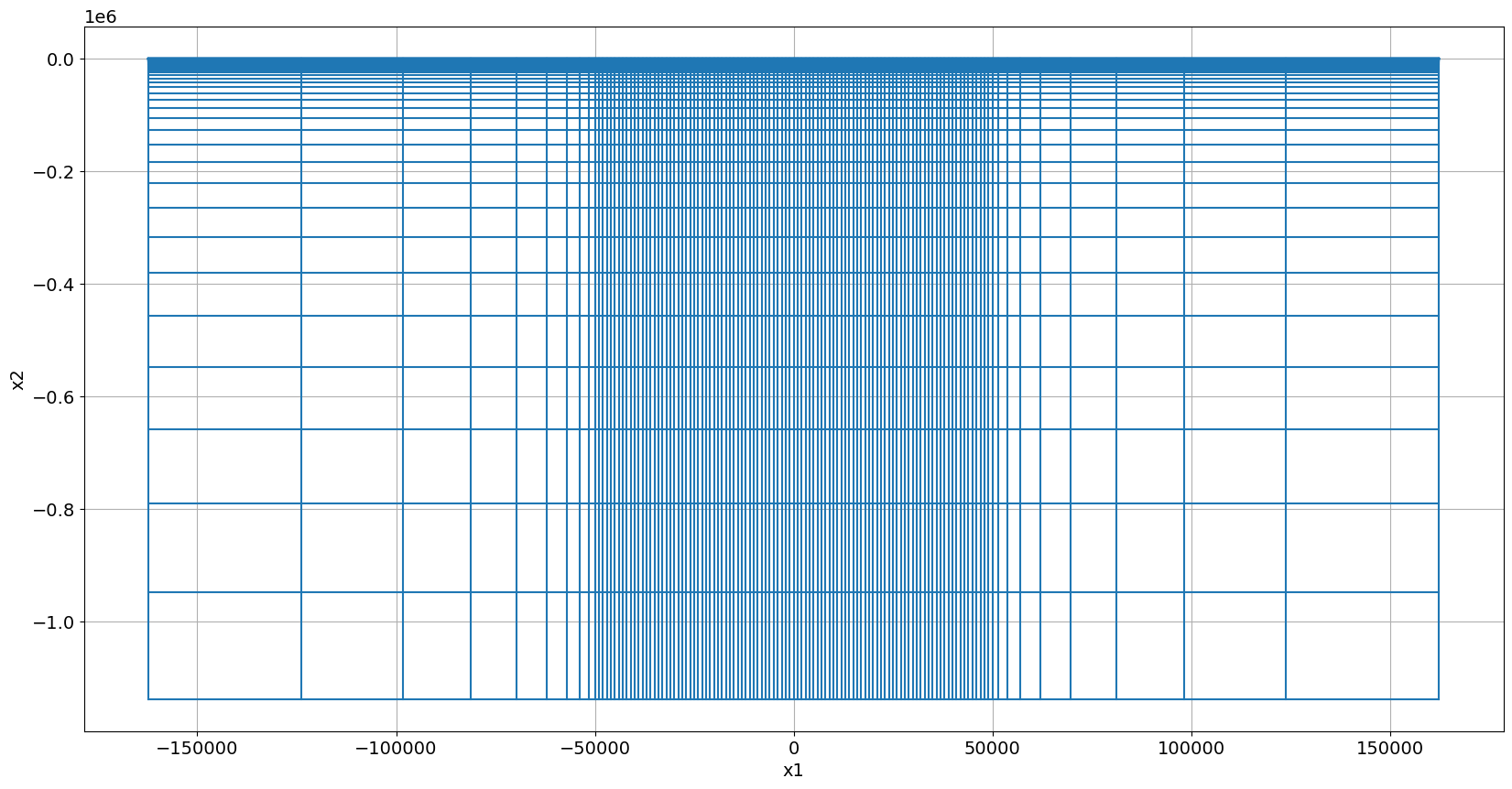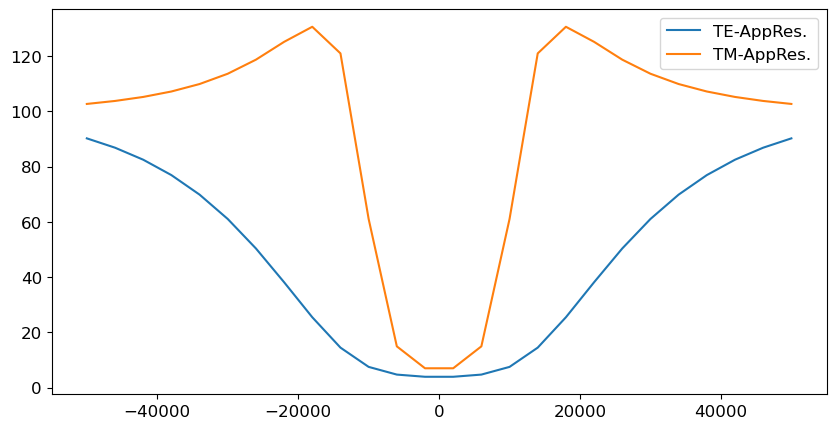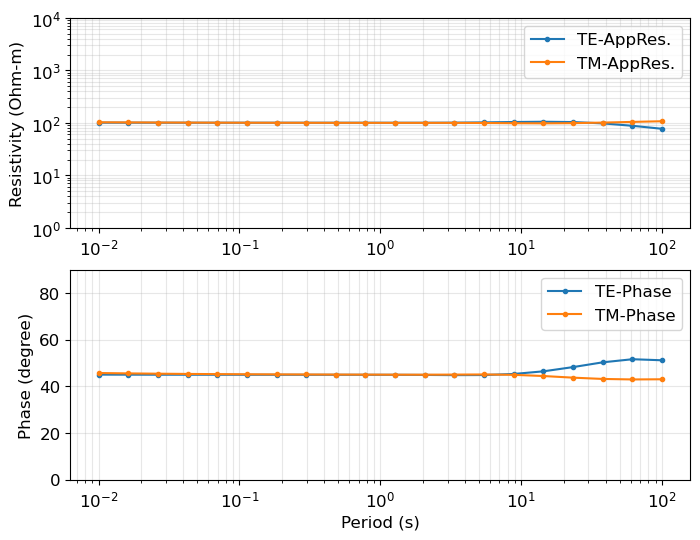Learning goals¶
Identify Transverse Electric (TE) and Transverse Magnetic (TM) modes.
Understand how to design mesh.
Understand spatial features of the transfer function in the form of apparent resistivity and phase
Explore how the transfer function varies with frequency
import discretize
from discretize import utils as dis_utils
from simpeg.electromagnetics import natural_source as nsem
from simpeg import utils, maps
import numpy as np
import matplotlib.pyplot as plt
# from pymatsolver import Pardiso as Solver
from geoana.em.fdem import skin_depth
from matplotlib.colors import LogNorm
import matplotlib
matplotlib.rcParams['font.size'] = 14
import warnings
warnings.filterwarnings("ignore")# Specify Rx locations and frequencies
d_station = 4 * 1e3
n_rx = 26
x0 = 50 * 1e3
x = np.arange(n_rx) * d_station - x0
lx = x.max() - x.min()
rx_locs = np.c_[x, np.zeros(n_rx)]
frequencies = np.logspace(-2, 2, 20)
n_freq = len(frequencies)Step 1: Discretize the domain using a 2D Tensor Mesh¶
How do we set up padding cells for satisfying the boundary condition?¶
# Setting the smallest cell size in z-direction
sig_background = 1e-2
f_min = 1e-2
f_max = 1e2
factor_min = 5
factor_max = 20
dz_min = skin_depth(f_max, sig_background) / factor_max
print ("Suggested smallest cell size is: {:.1f} m".format(dz_min))Suggested smallest cell size is: 25.2 m
Design cells in vertical direction¶
print ("Suggested vertical dimension length is: {:.1f}km".format(skin_depth(f_min, sig_background) / 1e3 * factor_max))Suggested vertical dimension length is: 1006.6km
# Determine cell thicknesses from the surface downward
nz_down = 33
z_expansionFact_down = 1.2
hz_down = dz_min*z_expansionFact_down**np.arange(nz_down)[::-1]
print (f"{hz_down.sum() / 1e3:.1f} km")51.5 km
# Determine cell thicknesses from the surface upward
z_expansionFact_up = 1.5
npadz = 10
hz_up = [(dz_min, npadz, z_expansionFact_up)]
hz_up = dis_utils.unpack_widths(hz_up)
print (f"{hz_up.sum() / 1e3:.1f} km")
# Combine z cell heights
hz = np.r_[hz_down, hz_up]4.3 km
Design cells in lateral dimension¶
factor_spacing = 4
dx_min = d_station/factor_spacing
csx = np.round(dx_min)
# print (csx)
ncx = int(lx / csx)
npadx = 11
pfx = 1.5
hx_pad = dis_utils.unpack_widths([(dx_min, npadx, -pfx)])
print (hx_pad.sum()/1e3)
hx = [(dx_min, npadx, -pfx), (dx_min, ncx), (csx, npadx, pfx)]256.49267578125
mesh = discretize.TensorMesh([hx, hz])
mesh.origin = np.r_[-mesh.h[0][:npadx].sum()+rx_locs[:,0].min(), -hz_down.sum()]mesh.plot_grid()
plt.gca().set_aspect(1)
print(mesh)
TensorMesh: 5,246 cells
MESH EXTENT CELL WIDTH FACTOR
dir nC min max min max max
--- --- --------------------------- ------------------ ------
x 122 -306,492.68 306,492.68 1,000.00 86,497.56 1.50
y 43 -51,485.06 4,277.86 25.16 8,601.81 1.50
Put all things together to generate a mesh¶
def generate_2d_mesh_for_mt(
rx_locs, frequencies, sigma_background,
z_factor_max=5,
z_factor_min=5,
pfz_down = 1.2,
pfz_up = 1.5,
npadz_up = 5,
x_factor_max = 2,
spacing_factor = 4,
pfx = 1.5,
n_max=1000
):
# Setting the cells in depth dimension
f_min = frequencies.min()
f_max = frequencies.max()
dz_min = np.round(skin_depth(f_max, sigma_background) / z_factor_max)
lz = skin_depth(f_min, sig_background) * z_factor_max
# Setting the domain length in z-direction
for nz_down in range(n_max):
hz_down = dz_min*pfz_down**np.arange(nz_down)[::-1]
if hz_down.sum()>lz:
break
hz_up = [(dz_min, npadz_up, pfz_up)]
hz_up = dis_utils.unpack_widths(hz_up)
hz = np.r_[hz_down, hz_up]
# Setting the cells in lateral dimension
d_station = np.diff(rx_locs[:,0]).min()
dx_min = np.round(d_station/spacing_factor)
lx = rx_locs[:,0].max() - rx_locs[:,0].min()
ncx = int(lx / dx_min)
lx_pad = skin_depth(sig_background, f_min) * x_factor_max
for npadx in range(n_max):
hx_pad = dis_utils.unpack_widths([(dx_min, npadx, -pfx)])
if hx_pad.sum()>lx_pad:
break
hx = [(dx_min, npadx, -pfx), (dx_min, ncx), (csx, npadx, pfx)]
mesh = discretize.TensorMesh([hx, hz])
mesh.origin = np.r_[-mesh.h[0][:npadx].sum()+rx_locs[:,0].min(), -hz_down.sum()]
print (mesh)
return meshmesh = generate_2d_mesh_for_mt(rx_locs, frequencies, 1e-2, z_factor_max=20)
TensorMesh: 6,490 cells
MESH EXTENT CELL WIDTH FACTOR
dir nC min max min max max
--- --- --------------------------- ------------------ ------
x 118 -162,330.08 162,330.08 1,000.00 38,443.36 1.50
y 55 -1,137,429.77 494.53 25.00 189,592.46 1.50
fig, ax = plt.subplots()
fig.set_figheight(10)
fig.set_figwidth(20)
mesh.plot_grid(ax=ax)
# ax.set_aspect('equal', 'box')<Axes: xlabel='x1', ylabel='x2'>
Step 2: Generate a conductivity model¶
sigma_background = 1e-2
sigma_block = 1e0
# sigma_block = 1e-2
sigma_air = 1e-8
cells = mesh.cell_centers
sigma = np.ones(mesh.n_cells) * sigma_background
blk_ind = utils.model_builder.get_indices_block(np.r_[-10000, -5000], np.r_[10000, -10000], cells)
sigma[blk_ind] = sigma_block
sigma[cells[:, -1] >= 0] = sigma_airfig, ax = plt.subplots(1,1, figsize=(10, 10))
grid= False
out = mesh.plot_image(
sigma, grid=grid, ax=ax, pcolor_opts={'norm':LogNorm(vmin=1e-4, vmax=1), 'cmap':'turbo'},
range_x=(-60000, 60000), range_y=(-30000, 2000)
)
ax.plot(rx_locs[:,0], rx_locs[:,1], 'ro')
cb = plt.colorbar(out[0], fraction=0.01)
cb.set_label("Conductivity (S/m)")
ax.set_aspect(1)
ax.set_xlabel("Easting (m)")
ax.set_ylabel("Elevation (m)")

Step 3: Setup Survey and Simulation¶
# simulation class for TE mode
rx_list_tm = [
nsem.receivers.PointNaturalSource(
rx_locs, orientation="xy", component="apparent_resistivity"
),
nsem.receivers.PointNaturalSource(
rx_locs, orientation="xy", component="phase"
),
]
src_list_tm = [nsem.sources.Planewave(rx_list_tm, frequency=f) for f in frequencies]
survey_tm = nsem.Survey(src_list_tm)
sim_tm= nsem.simulation.Simulation2DElectricField(
mesh,
survey=survey_tm,
sigma=sigma,
)
# simulation class for TE mode
rx_list_te = [
nsem.receivers.PointNaturalSource(
rx_locs, orientation="yx", component="apparent_resistivity"
),
nsem.receivers.PointNaturalSource(
rx_locs, orientation="yx", component="phase",
),
]
src_list_te = [nsem.sources.Planewave(rx_list_te, frequency=f) for f in frequencies]
survey_te = nsem.Survey(src_list_te)
sim_te = nsem.simulation.Simulation2DMagneticField(
mesh,
survey=survey_te,
sigma=sigma,
)Step 4: Run forward modelling¶
f_te = sim_te.fields()
pred_te = sim_te.dpred(f=f_te)
f_tm = sim_tm.fields()
pred_tm = sim_tm.dpred(f=f_tm)# extract fields
i_freq = 0
e_te = f_te[src_list_te[i_freq], 'e']
h_te = f_te[src_list_te[i_freq], 'h']
e_tm = f_tm[src_list_tm[i_freq], 'e']
h_tm = f_tm[src_list_tm[i_freq], 'h']Plot fields from the Transverse Magnetic Mode¶
fig, ax = plt.subplots(1,1, figsize=(10, 10))
out = mesh.plot_image(e_tm.real, v_type='E', view='vec', ax=ax, range_x=(-60000, 60000), range_y=(-30000, 0))
cb = plt.colorbar(out[0], fraction=0.01)
cb.set_label("Field")
ax.set_aspect(1)
ax.set_ylim(-30000, 0)
ax.set_xlim(-60000, 60000)
ax.set_xlabel("Easting (m)")
ax.set_ylabel("Elevation (m)")
fig, ax = plt.subplots(1,1, figsize=(10, 10))
out = mesh.plot_image(
h_tm.real, v_type='CC', ax=ax, range_x=(-60000, 60000), range_y=(-30000, 0),
pcolor_opts={'cmap':'plasma'}
)
cb = plt.colorbar(out[0], fraction=0.01)
cb.set_label("Field")
ax.set_aspect(1)
ax.set_ylim(-30000, 0)
ax.set_xlim(-60000, 60000)
ax.set_xlabel("Easting (m)")
ax.set_ylabel("Elevation (m)")
Plot fields from the Transverse Electric Mode¶
fig, ax = plt.subplots(1,1, figsize=(10, 10))
out = mesh.plot_image(e_te.real, v_type='CC', ax=ax, range_x=(-60000, 60000), range_y=(-30000, 0))
cb = plt.colorbar(out[0], fraction=0.01)
cb.set_label("Field")
ax.set_aspect(1)
ax.set_ylim(-30000, 0)
ax.set_xlim(-60000, 60000)
ax.set_xlabel("Easting (m)")
ax.set_ylabel("Elevation (m)")
fig, ax = plt.subplots(1,1, figsize=(10, 10))
out = mesh.plot_image(
h_te.real, v_type='E', view='vec', ax=ax, range_x=(-60000, 60000), range_y=(-30000, 0),
pcolor_opts={'cmap':'plasma'}, stream_opts={'color':'w'}
)
cb = plt.colorbar(out[0], fraction=0.01)
cb.set_label("Field")
ax.set_aspect(1)
ax.set_ylim(-30000, 0)
ax.set_xlim(-60000, 60000)
ax.set_xlabel("Easting (m)")
ax.set_ylabel("Elevation (m)")
PRED_te = pred_te.reshape((n_freq, 2, n_rx))
PRED_tm = pred_tm.reshape((n_freq, 2, n_rx))
rho_app_te = PRED_te[:,0,:]
rho_app_tm = PRED_tm[:,0,:]
phase_te = PRED_te[:,1,:]
phase_tm = PRED_tm[:,1,:]from ipywidgets import widgets, interactimport matplotlib
matplotlib.rcParams['font.size'] = 12
def foo_te(kk, mode):
fig, axs = plt.subplots(2, 1, figsize=(8, 5))
for i_freq in range(kk):
ax1, ax2 = axs
if mode == 'TE':
ax1.semilogy(rx_locs[:,0], rho_app_te[i_freq,:], '-', label='TE-AppRes.', color='C0')
ax2.plot(rx_locs[:,0], phase_te[i_freq,:], '-', label='TE-Pha.', color='C0')
elif mode == 'TM':
ax1.semilogy(rx_locs[:,0], rho_app_tm[i_freq,:], '-', label='TM-AppRes.', color='C1')
ax2.plot(rx_locs[:,0], phase_tm[i_freq,:]+180, '-', label='TM-Pha.', color='C1')
ax1.set_title("Frequency at {:.1e} Hz".format(frequencies[i_freq]))
ax1.set_xticklabels([])
ax1.set_ylim(1, 1e3)
ax2.set_ylim(0, 90)
ax1.set_ylabel("Apparent resistivity (Ohm-m)")
ax2.set_ylabel("Phase (degree)")Investigate how apparent resistivity and phase change as a function of ferquency¶
interact(
foo_te,
kk=widgets.IntSlider(min=1, max=len(frequencies), value=1, continuous_update=True),
mode=widgets.RadioButtons(options=['TE', 'TM'])
)Loading...
For a simgle frequency compare the apparent resistivity of the TE and TM modes¶
fig, ax1 = plt.subplots(1, 1, figsize=(10, 5))
i_freq = 0
ax1.plot(rx_locs[:,0], rho_app_te[i_freq,:], '-', label='TE-AppRes.', color='C0')
ax1.plot(rx_locs[:,0], rho_app_tm[i_freq,:], '-', label='TM-AppRes.', color='C1')
# ax1.set_ylim(50, 2e2)
ax1.legend()
Create apparent resistivity and phase plots for different stations within the profile¶
i_sounding = 3
fig, axs = plt.subplots(2, 1, figsize=(8, 6))
ax1, ax2 = axs
ax1.loglog(1./frequencies, rho_app_te[:,i_sounding], '.-', label='TE-AppRes.')
ax1.loglog(1./frequencies, rho_app_tm[:,i_sounding], '.-', label='TM-AppRes.')
ax1.legend()
ax1.set_ylim(1, 1e4)
ax2.semilogx(1./frequencies, phase_te[:,i_sounding], '.-', label='TE-Phase')
ax2.semilogx(1./frequencies, phase_tm[:,i_sounding]+180, '.-', label='TM-Phase')
ax2.set_ylim(0, 90)
ax2.legend()
for ax in axs:
ax.grid(True, which='both', alpha=0.3)
ax1.set_ylabel("Resistivity (Ohm-m)")
ax2.set_ylabel("Phase (degree)")
ax2.set_xlabel('Period (s)')
noise_rho_app_te = 0.05 * abs(rho_app_te) * np.random.randn(len(frequencies), n_rx)
noise_rho_app_tm = 0.05 * abs(rho_app_tm) * np.random.randn(len(frequencies), n_rx)
noise_phase_te = 2 * np.ones_like(phase_te) * np.random.randn(len(frequencies), n_rx)
noise_phase_tm = 2 * np.ones_like(phase_tm) * np.random.randn(len(frequencies), n_rx)Lets try to make these plots using MTpy instead!¶
# This could have been better if we could use MTpy
import dill
output_results ={
'rx_locs': rx_locs,
'frequencies': frequencies,
'app_rho_te': rho_app_te+noise_rho_app_te,
'app_rho_tm': rho_app_tm+noise_rho_app_tm,
'phase_te': phase_te+noise_phase_te,
'phase_tm': phase_tm+noise_phase_tm,
'mesh': mesh,
'sigma': sigma
}
dill.dump(output_results, open("./synthetic_2d.pik", "wb"))Create MTpy object and save as MTH5 format¶
import numpy as np
from mtpy import MTCollection
from mtpy import MT
from mtpy.core import Z
mc = MTCollection()
mc.open_collection(filename="./2d_mth5.h5")
for i_rx in range(n_rx):
app_rho_matrix = np.zeros((n_freq, 2, 2), dtype=float)
phase_matrix = np.zeros((n_freq, 2, 2), dtype=float)
app_rho_matrix[:,0,1] = output_results['app_rho_te'][:,i_rx]
app_rho_matrix[:,1,0] = output_results['app_rho_tm'][:,i_rx]
phase_matrix[:,0,1] = output_results['phase_te'][:,i_rx]
phase_matrix[:,1,0] = output_results['phase_tm'][:,i_rx]
# or add apparent resistivity and phase
z_object = Z()
z_object.set_resistivity_phase(app_rho_matrix, phase_matrix, frequencies)
dx_lon = d_station / 1e5
response = MT()
response.Z = z_object
response.survey_metadata.id = "model_2d_response"
response.station_metadata.id = "mt-{:d}".format(i_rx)
response.station_metadata.transfer_function.id = "mt-{:d}".format(i_rx)
# if this is 2D maybe we need a location
response.station_metadata.location.latitude = 40
response.station_metadata.location.longitude = -122 + dx_lon * (i_rx)
mc.add_tf(response)
mc.close_collection()24:10:28T23:07:48 | WARNING | line:256 |mtpy.core.mt_collection | add_tf | If you are adding multiple transfer functions, suggest making a list of transfer functions first then adding the list using mt_collection.add_tf([list_of_tfs]). Otherwise adding transfer functions one by one will be slow.
24:10:28T23:07:48 | INFO | line:399 |mtpy.core.mt_collection | _from_mt_object | added model_2d_response.mt-0
24:10:28T23:07:48 | WARNING | line:256 |mtpy.core.mt_collection | add_tf | If you are adding multiple transfer functions, suggest making a list of transfer functions first then adding the list using mt_collection.add_tf([list_of_tfs]). Otherwise adding transfer functions one by one will be slow.
24:10:28T23:07:48 | INFO | line:399 |mtpy.core.mt_collection | _from_mt_object | added model_2d_response.mt-1
24:10:28T23:07:48 | WARNING | line:256 |mtpy.core.mt_collection | add_tf | If you are adding multiple transfer functions, suggest making a list of transfer functions first then adding the list using mt_collection.add_tf([list_of_tfs]). Otherwise adding transfer functions one by one will be slow.
24:10:28T23:07:48 | INFO | line:399 |mtpy.core.mt_collection | _from_mt_object | added model_2d_response.mt-2
24:10:28T23:07:49 | WARNING | line:256 |mtpy.core.mt_collection | add_tf | If you are adding multiple transfer functions, suggest making a list of transfer functions first then adding the list using mt_collection.add_tf([list_of_tfs]). Otherwise adding transfer functions one by one will be slow.
24:10:28T23:07:49 | INFO | line:399 |mtpy.core.mt_collection | _from_mt_object | added model_2d_response.mt-3
24:10:28T23:07:49 | WARNING | line:256 |mtpy.core.mt_collection | add_tf | If you are adding multiple transfer functions, suggest making a list of transfer functions first then adding the list using mt_collection.add_tf([list_of_tfs]). Otherwise adding transfer functions one by one will be slow.
24:10:28T23:07:49 | INFO | line:399 |mtpy.core.mt_collection | _from_mt_object | added model_2d_response.mt-4
24:10:28T23:07:49 | WARNING | line:256 |mtpy.core.mt_collection | add_tf | If you are adding multiple transfer functions, suggest making a list of transfer functions first then adding the list using mt_collection.add_tf([list_of_tfs]). Otherwise adding transfer functions one by one will be slow.
24:10:28T23:07:49 | INFO | line:399 |mtpy.core.mt_collection | _from_mt_object | added model_2d_response.mt-5
24:10:28T23:07:50 | WARNING | line:256 |mtpy.core.mt_collection | add_tf | If you are adding multiple transfer functions, suggest making a list of transfer functions first then adding the list using mt_collection.add_tf([list_of_tfs]). Otherwise adding transfer functions one by one will be slow.
24:10:28T23:07:50 | INFO | line:399 |mtpy.core.mt_collection | _from_mt_object | added model_2d_response.mt-6
24:10:28T23:07:50 | WARNING | line:256 |mtpy.core.mt_collection | add_tf | If you are adding multiple transfer functions, suggest making a list of transfer functions first then adding the list using mt_collection.add_tf([list_of_tfs]). Otherwise adding transfer functions one by one will be slow.
24:10:28T23:07:50 | INFO | line:399 |mtpy.core.mt_collection | _from_mt_object | added model_2d_response.mt-7
24:10:28T23:07:50 | WARNING | line:256 |mtpy.core.mt_collection | add_tf | If you are adding multiple transfer functions, suggest making a list of transfer functions first then adding the list using mt_collection.add_tf([list_of_tfs]). Otherwise adding transfer functions one by one will be slow.
24:10:28T23:07:50 | INFO | line:399 |mtpy.core.mt_collection | _from_mt_object | added model_2d_response.mt-8
24:10:28T23:07:50 | WARNING | line:256 |mtpy.core.mt_collection | add_tf | If you are adding multiple transfer functions, suggest making a list of transfer functions first then adding the list using mt_collection.add_tf([list_of_tfs]). Otherwise adding transfer functions one by one will be slow.
24:10:28T23:07:50 | INFO | line:399 |mtpy.core.mt_collection | _from_mt_object | added model_2d_response.mt-9
24:10:28T23:07:51 | WARNING | line:256 |mtpy.core.mt_collection | add_tf | If you are adding multiple transfer functions, suggest making a list of transfer functions first then adding the list using mt_collection.add_tf([list_of_tfs]). Otherwise adding transfer functions one by one will be slow.
24:10:28T23:07:51 | INFO | line:399 |mtpy.core.mt_collection | _from_mt_object | added model_2d_response.mt-10
24:10:28T23:07:51 | WARNING | line:256 |mtpy.core.mt_collection | add_tf | If you are adding multiple transfer functions, suggest making a list of transfer functions first then adding the list using mt_collection.add_tf([list_of_tfs]). Otherwise adding transfer functions one by one will be slow.
24:10:28T23:07:51 | INFO | line:399 |mtpy.core.mt_collection | _from_mt_object | added model_2d_response.mt-11
24:10:28T23:07:51 | WARNING | line:256 |mtpy.core.mt_collection | add_tf | If you are adding multiple transfer functions, suggest making a list of transfer functions first then adding the list using mt_collection.add_tf([list_of_tfs]). Otherwise adding transfer functions one by one will be slow.
24:10:28T23:07:51 | INFO | line:399 |mtpy.core.mt_collection | _from_mt_object | added model_2d_response.mt-12
24:10:28T23:07:52 | WARNING | line:256 |mtpy.core.mt_collection | add_tf | If you are adding multiple transfer functions, suggest making a list of transfer functions first then adding the list using mt_collection.add_tf([list_of_tfs]). Otherwise adding transfer functions one by one will be slow.
24:10:28T23:07:52 | INFO | line:399 |mtpy.core.mt_collection | _from_mt_object | added model_2d_response.mt-13
24:10:28T23:07:52 | WARNING | line:256 |mtpy.core.mt_collection | add_tf | If you are adding multiple transfer functions, suggest making a list of transfer functions first then adding the list using mt_collection.add_tf([list_of_tfs]). Otherwise adding transfer functions one by one will be slow.
24:10:28T23:07:52 | INFO | line:399 |mtpy.core.mt_collection | _from_mt_object | added model_2d_response.mt-14
24:10:28T23:07:52 | WARNING | line:256 |mtpy.core.mt_collection | add_tf | If you are adding multiple transfer functions, suggest making a list of transfer functions first then adding the list using mt_collection.add_tf([list_of_tfs]). Otherwise adding transfer functions one by one will be slow.
24:10:28T23:07:52 | INFO | line:399 |mtpy.core.mt_collection | _from_mt_object | added model_2d_response.mt-15
24:10:28T23:07:52 | WARNING | line:256 |mtpy.core.mt_collection | add_tf | If you are adding multiple transfer functions, suggest making a list of transfer functions first then adding the list using mt_collection.add_tf([list_of_tfs]). Otherwise adding transfer functions one by one will be slow.
24:10:28T23:07:52 | INFO | line:399 |mtpy.core.mt_collection | _from_mt_object | added model_2d_response.mt-16
24:10:28T23:07:53 | WARNING | line:256 |mtpy.core.mt_collection | add_tf | If you are adding multiple transfer functions, suggest making a list of transfer functions first then adding the list using mt_collection.add_tf([list_of_tfs]). Otherwise adding transfer functions one by one will be slow.
24:10:28T23:07:53 | INFO | line:399 |mtpy.core.mt_collection | _from_mt_object | added model_2d_response.mt-17
24:10:28T23:07:53 | WARNING | line:256 |mtpy.core.mt_collection | add_tf | If you are adding multiple transfer functions, suggest making a list of transfer functions first then adding the list using mt_collection.add_tf([list_of_tfs]). Otherwise adding transfer functions one by one will be slow.
24:10:28T23:07:53 | INFO | line:399 |mtpy.core.mt_collection | _from_mt_object | added model_2d_response.mt-18
24:10:28T23:07:53 | WARNING | line:256 |mtpy.core.mt_collection | add_tf | If you are adding multiple transfer functions, suggest making a list of transfer functions first then adding the list using mt_collection.add_tf([list_of_tfs]). Otherwise adding transfer functions one by one will be slow.
24:10:28T23:07:53 | INFO | line:399 |mtpy.core.mt_collection | _from_mt_object | added model_2d_response.mt-19
24:10:28T23:07:53 | WARNING | line:256 |mtpy.core.mt_collection | add_tf | If you are adding multiple transfer functions, suggest making a list of transfer functions first then adding the list using mt_collection.add_tf([list_of_tfs]). Otherwise adding transfer functions one by one will be slow.
24:10:28T23:07:53 | INFO | line:399 |mtpy.core.mt_collection | _from_mt_object | added model_2d_response.mt-20
24:10:28T23:07:54 | WARNING | line:256 |mtpy.core.mt_collection | add_tf | If you are adding multiple transfer functions, suggest making a list of transfer functions first then adding the list using mt_collection.add_tf([list_of_tfs]). Otherwise adding transfer functions one by one will be slow.
24:10:28T23:07:54 | INFO | line:399 |mtpy.core.mt_collection | _from_mt_object | added model_2d_response.mt-21
24:10:28T23:07:54 | WARNING | line:256 |mtpy.core.mt_collection | add_tf | If you are adding multiple transfer functions, suggest making a list of transfer functions first then adding the list using mt_collection.add_tf([list_of_tfs]). Otherwise adding transfer functions one by one will be slow.
24:10:28T23:07:54 | INFO | line:399 |mtpy.core.mt_collection | _from_mt_object | added model_2d_response.mt-22
24:10:28T23:07:54 | WARNING | line:256 |mtpy.core.mt_collection | add_tf | If you are adding multiple transfer functions, suggest making a list of transfer functions first then adding the list using mt_collection.add_tf([list_of_tfs]). Otherwise adding transfer functions one by one will be slow.
24:10:28T23:07:54 | INFO | line:399 |mtpy.core.mt_collection | _from_mt_object | added model_2d_response.mt-23
24:10:28T23:07:54 | WARNING | line:256 |mtpy.core.mt_collection | add_tf | If you are adding multiple transfer functions, suggest making a list of transfer functions first then adding the list using mt_collection.add_tf([list_of_tfs]). Otherwise adding transfer functions one by one will be slow.
24:10:28T23:07:54 | INFO | line:399 |mtpy.core.mt_collection | _from_mt_object | added model_2d_response.mt-24
24:10:28T23:07:55 | WARNING | line:256 |mtpy.core.mt_collection | add_tf | If you are adding multiple transfer functions, suggest making a list of transfer functions first then adding the list using mt_collection.add_tf([list_of_tfs]). Otherwise adding transfer functions one by one will be slow.
24:10:28T23:07:55 | INFO | line:399 |mtpy.core.mt_collection | _from_mt_object | added model_2d_response.mt-25
24:10:28T23:07:56 | INFO | line:777 |mth5.mth5 | close_mth5 | Flushing and closing 2d_mth5.h5
from mtpy import MTCollection
mc = MTCollection()
mc.open_collection("./2d_mth5.h5")from ipywidgets import widgets, interact
station_names = mc.dataframe.station.values
def foo(name):
tf = mc.get_tf(name)
tf.plot_mt_response()List station names since they are unfortunately not in order¶
print(station_names)['mt-0' 'mt-1' 'mt-10' 'mt-11' 'mt-12' 'mt-13' 'mt-14' 'mt-15' 'mt-16'
'mt-17' 'mt-18' 'mt-19' 'mt-2' 'mt-20' 'mt-21' 'mt-22' 'mt-23' 'mt-24'
'mt-25' 'mt-3' 'mt-4' 'mt-5' 'mt-6' 'mt-7' 'mt-8' 'mt-9']
Create plots using MTpy¶
foo(station_names[5])24:10:28T23:38:22 | WARNING | line:311 |mtpy.core.mt_collection | get_tf | Found multiple transfer functions with ID mt-13. Suggest setting survey, otherwise returning the TF from survey model_2d_response.
